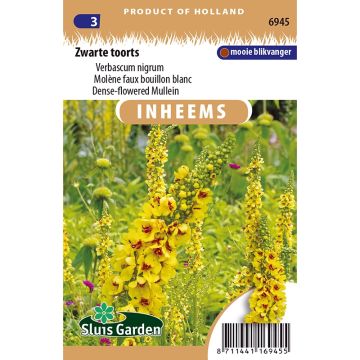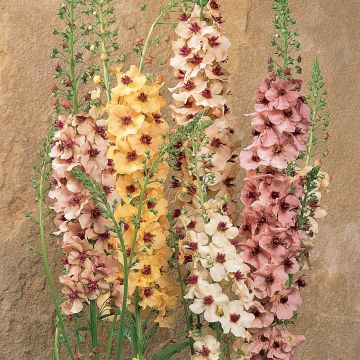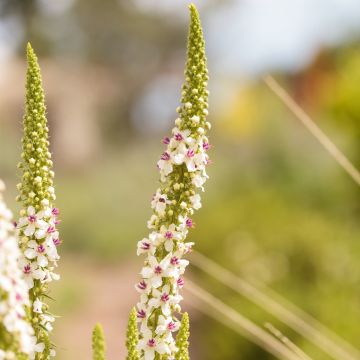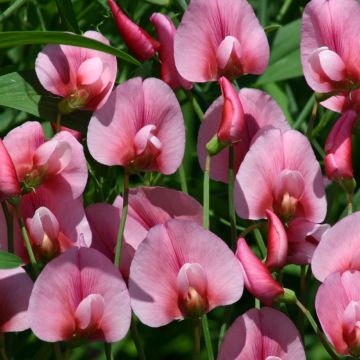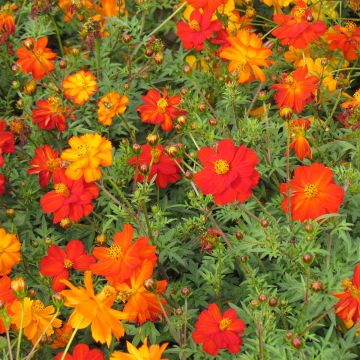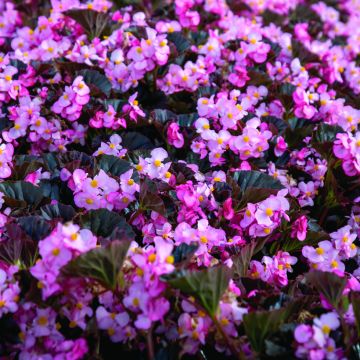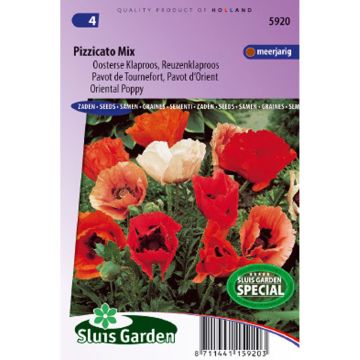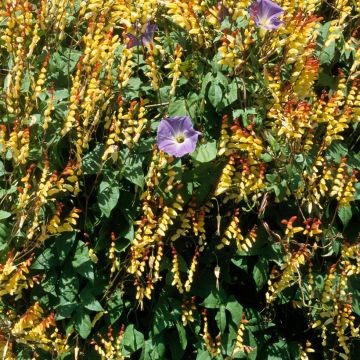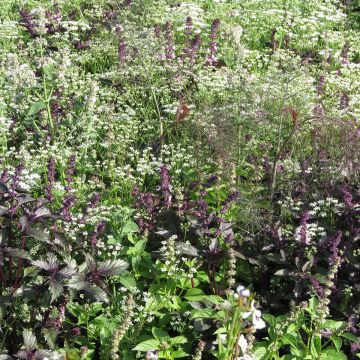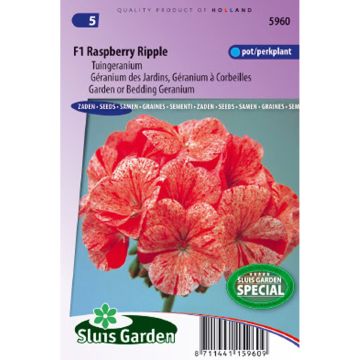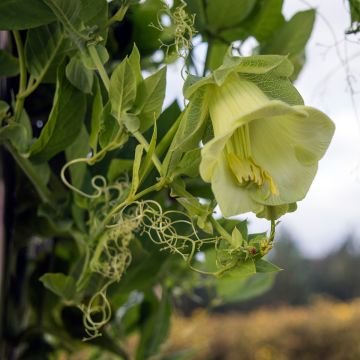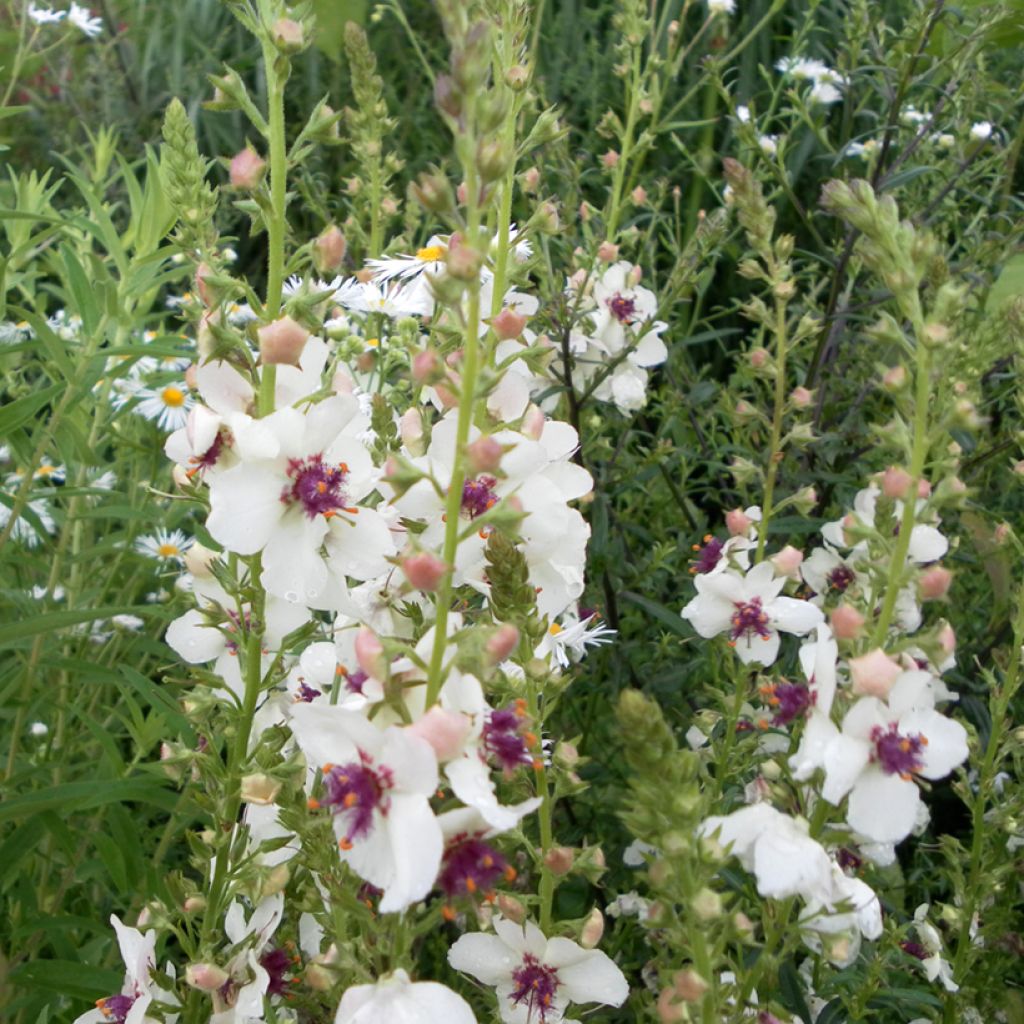

Verbascum blattaria Albiflorum seeds - Moth mullein
Verbascum blattaria Albiflorum seeds - Moth mullein
Verbascum blattaria Albiflorum
Moth mullein, Moth plant
This item cannot be shipped to the selected country
Dispatch by letter from €3.90
More information
Schedule delivery date,
and select date in basket
This plant carries a 6 months recovery warranty
More information
We guarantee the quality of our plants for a full growing cycle, and will replace at our expense any plant that fails to recover under normal climatic and planting conditions.
Seed-only orders are dispatched by sealed envelope. The delivery charge for seed-only orders is €3.90.
Does this plant fit my garden?
Set up your Plantfit profile →
Description
Verbascum blattaria 'Albiflorum' is the white form of the moth mullein, a botanical species native in Europe. It is a biennial plant that will charm with its delicacy, its spikes of white florets, and its ability to adapt to dry terrains. Its wild aspect brings height, lightness, and movement to the garden. It thrives in sunny locations, whether in a large flower border or in a mass planting, where its bright flowers combine wonderfully with other plants suited to dry soil.
Verbascum blattaria is also known by the common names of Moth Mullein or Flannel Mullein. Like all mulleins, it belongs to the Scrophulariaceae family. It is a species native to Europe, Western Asia, and North Africa. This plant is often found in the wild in dry meadows, along paths, fallow lands, and rocky areas. It prefers sunny and limestone environments, easily establishing itself in open and disturbed habitats. The plant is biennial, meaning it forms a rosette of leaves in the first year before flowering in the second. It can even behave as an annual and flower in the year of sowing, depending on the climate and/or sowing date.
The 'Albiflorum' form stands out with its pure white flowers, clustered in upright spikes. Each flower measures 2.5 to 3 cm in diameter and has five rounded petals, with prominent violet stamens bearing orange anthers. These are pedunculate flowers, well spaced along the stem covered with glandular hairs. The foliage of this white mullein forms a narrow basal rosette composed of lanceolate, dark green leaves, with toothed edges, measuring between 5 and 15 cm long. The lower leaves have petioles, while those on the stem are sessile, smaller, and narrower. The erect, unbranched floral spikes can reach up to 1 m high in rich, moist soil. However, the plant will remain much smaller in poor, dry soil. Flowering occurs from June to September, and after flowering, capsules form containing seeds that readily self-sow in light soils. The moth mullein develops a long taproot that enables it to withstand drought. Plants grown from seed will become self-sufficient more quickly and require less watering.
A graceful plant of open spaces, Verbascum blattaria 'Albiflorum' is a blessing for natural gardens. This undemanding plant will be much more decorative if it benefits from soil that is not too poor with occasional watering during very dry periods. Pair mulleins with hollyhocks, toadflaxes, tall ornamental thistles, and Verbena bonariensis. They are also good companions for clustered rose bushes. It is advisable to surround them with perennials or shrubs to fill the space when they are not in bloom.
Report an error about the product description
Flowering
Foliage
Plant habit
Botanical data
Verbascum
blattaria
Albiflorum
Schrophulariaceae
Moth mullein, Moth plant
Verbascum blattaria 'Albiflorum'
Western Europe
Other Verbascum seeds
Planting and care
Sow your Verbascum blattaria 'Albiflorum' seeds in April-May or September-October, in a seed tray or directly in the ground. Plants from direct sowing are more reliable and longer-lasting.
In a seed tray: sow in trays or boxes filled with seed compost, at a depth of 1.5 mm. Place your seedlings in a heated propagator or in a warm place to maintain an optimal temperature between 15 and 18 °C. Germination usually takes 3 weeks.
Transplant the young plants when they are sufficiently developed to be handled, into 8 cm diameter pots. When the seedlings are well rooted, plant them in their final location in autumn or spring. Maintain a distance of 30 cm between each plant.
In the ground: direct sow in spring or late summer, in well-prepared soil, lightened with sand and compost if necessary, and free of any weeds or roots. Keep only one plant every 50 cm.
Culture:
Verbascum blattaria 'Albiflorum' should be planted in full sun, or partial shade in very hot and sunny regions. This mullein should be planted in ordinary but well-drained soil: it dislikes very wet and waterlogged soils. It prefers limestone soil, moist to dry in summer, where it will readily self-seed. Cut faded inflorescences at the base of the stem to promote flower reblooming and plant longevity. Trim dry parts when they are no longer decorative and clean the clump no later than late winter. If you let some seeds ripen, your mullein can self-seed spontaneously in the garden, in light soil.
Sowing period
Intended location
This item has not been reviewed yet - be the first to leave a review about it.
Flower seeds
Haven't found what you were looking for?
Hardiness is the lowest winter temperature a plant can endure without suffering serious damage or even dying. However, hardiness is affected by location (a sheltered area, such as a patio), protection (winter cover) and soil type (hardiness is improved by well-drained soil).

Photo Sharing Terms & Conditions
In order to encourage gardeners to interact and share their experiences, Promesse de fleurs offers various media enabling content to be uploaded onto its Site - in particular via the ‘Photo sharing’ module.
The User agrees to refrain from:
- Posting any content that is illegal, prejudicial, insulting, racist, inciteful to hatred, revisionist, contrary to public decency, that infringes on privacy or on the privacy rights of third parties, in particular the publicity rights of persons and goods, intellectual property rights, or the right to privacy.
- Submitting content on behalf of a third party;
- Impersonate the identity of a third party and/or publish any personal information about a third party;
In general, the User undertakes to refrain from any unethical behaviour.
All Content (in particular text, comments, files, images, photos, videos, creative works, etc.), which may be subject to property or intellectual property rights, image or other private rights, shall remain the property of the User, subject to the limited rights granted by the terms of the licence granted by Promesse de fleurs as stated below. Users are at liberty to publish or not to publish such Content on the Site, notably via the ‘Photo Sharing’ facility, and accept that this Content shall be made public and freely accessible, notably on the Internet.
Users further acknowledge, undertake to have ,and guarantee that they hold all necessary rights and permissions to publish such material on the Site, in particular with regard to the legislation in force pertaining to any privacy, property, intellectual property, image, or contractual rights, or rights of any other nature. By publishing such Content on the Site, Users acknowledge accepting full liability as publishers of the Content within the meaning of the law, and grant Promesse de fleurs, free of charge, an inclusive, worldwide licence for the said Content for the entire duration of its publication, including all reproduction, representation, up/downloading, displaying, performing, transmission, and storage rights.
Users also grant permission for their name to be linked to the Content and accept that this link may not always be made available.
By engaging in posting material, Users consent to their Content becoming automatically accessible on the Internet, in particular on other sites and/or blogs and/or web pages of the Promesse de fleurs site, including in particular social pages and the Promesse de fleurs catalogue.
Users may secure the removal of entrusted content free of charge by issuing a simple request via our contact form.
The flowering period indicated on our website applies to countries and regions located in USDA zone 8 (France, the United Kingdom, Ireland, the Netherlands, etc.)
It will vary according to where you live:
- In zones 9 to 10 (Italy, Spain, Greece, etc.), flowering will occur about 2 to 4 weeks earlier.
- In zones 6 to 7 (Germany, Poland, Slovenia, and lower mountainous regions), flowering will be delayed by 2 to 3 weeks.
- In zone 5 (Central Europe, Scandinavia), blooming will be delayed by 3 to 5 weeks.
In temperate climates, pruning of spring-flowering shrubs (forsythia, spireas, etc.) should be done just after flowering.
Pruning of summer-flowering shrubs (Indian Lilac, Perovskia, etc.) can be done in winter or spring.
In cold regions as well as with frost-sensitive plants, avoid pruning too early when severe frosts may still occur.
The planting period indicated on our website applies to countries and regions located in USDA zone 8 (France, United Kingdom, Ireland, Netherlands).
It will vary according to where you live:
- In Mediterranean zones (Marseille, Madrid, Milan, etc.), autumn and winter are the best planting periods.
- In continental zones (Strasbourg, Munich, Vienna, etc.), delay planting by 2 to 3 weeks in spring and bring it forward by 2 to 4 weeks in autumn.
- In mountainous regions (the Alps, Pyrenees, Carpathians, etc.), it is best to plant in late spring (May-June) or late summer (August-September).
The harvesting period indicated on our website applies to countries and regions in USDA zone 8 (France, England, Ireland, the Netherlands).
In colder areas (Scandinavia, Poland, Austria...) fruit and vegetable harvests are likely to be delayed by 3-4 weeks.
In warmer areas (Italy, Spain, Greece, etc.), harvesting will probably take place earlier, depending on weather conditions.
The sowing periods indicated on our website apply to countries and regions within USDA Zone 8 (France, UK, Ireland, Netherlands).
In colder areas (Scandinavia, Poland, Austria...), delay any outdoor sowing by 3-4 weeks, or sow under glass.
In warmer climes (Italy, Spain, Greece, etc.), bring outdoor sowing forward by a few weeks.

































